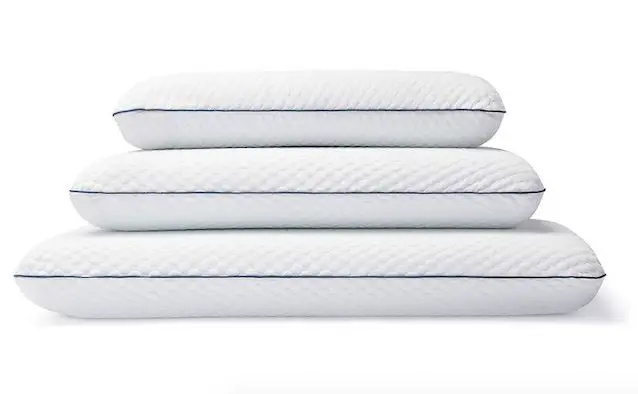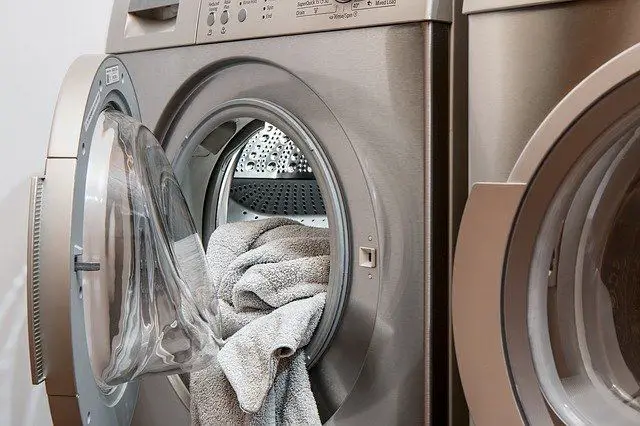Memory foam is known as one of the most comfortable materials for bedding, including mattresses and pillows. It’s soft, relaxing, and warm. However, that warmth can lead to sweating and frequent cleaning if you’re not doing it correctly. Don’t worry, though; there are a handful of methods that will keep your new pillow as good as new.
So, do you want to know how to wash your memory foam pillow at home? You can easily use a few common household products to get the job done in no time. Spot cleaning, deodorizers, and regular washing cycles will be more than enough.
Let’s dive into the steps that you need to take below. Remember to consult the general care guide for the quickest step-by-step from beginning to end.

Washing a Memory Foam Pillow

The best way to clean a memory foam pillow is by using laundry detergent, dish soap, or essential oils.
Make sure that you choose a gentle formula for any products that you use on memory foam since it can get dried out and tear easily. You should also pick out a scent that you’re comfortable with now that it’ll be right by your head when you sleep.
Anyway, here’s the washing process:
- Depending on the size of your pillow, fill a tub, sink, or water basin about halfway from the top.
- Completely submerge the memory foam pillow, allowing it to absorb water throughout the entire porous surface. Memory foam is usually rather dense, so it might take a little while to soak it thoroughly.
- Lightly sprinkle laundry detergent into the water and on the pillow.
- Swish around the water and squeeze the pillow numerous times to suds up the cleaning solution.
- After about 45 seconds or so, you’ll notice that the water is light brown or grey (this is good! It’s the dirty water coming out of your pillow), which is when it’s time to drain the tub.
- Squeeze the pillow again while there’s no water in the tub to drain the dirty water held inside the material.
- Next, fill the water up again with warm water until the pillow is submerged once more.
- Squeeze the pillow as you did before, drain the water, and remove any excess water by kneading the surface.
- Since memory foam tends to hold onto soap, oils, and dirt, you might have to repeat the rinse cycle a few times.
- Continue to fill the tub, squeeze the pillow, and drain the water out of it until it comes out completely clear.
The whole process should take around 15 minutes or so, maybe even less if you do it frequently enough to prevent sweat from building up.
Spot Cleaning the Pillow

We’ve all made mistakes and dropped food or drinks onto a pillow. Although memory foam soaks everything up and stains quickly, it’s not the end of the world (or the pillow).
There are various types of stains, many of which are easy to remove. However, there are a couple of situations that you might need to do a deep spot clean on a memory foam pillow.
Here are the five steps to spot clean a memory foam pillow with mild to moderate stains:
- Remove the pillow from the case and throw the pillowcase into the laundry machine. You can wash it in a sink as well if it needs to soak a bit longer than the laundry machine allows for.
- Place the memory foam pillow on a flat surface to prevent it from moving around while you’re cleaning it. Keep in mind that liquids might pour out of the bottom of the pillow, staining the surface below. It’s not a bad idea to lay a towel underneath it to prevent this from happening.
- Mix laundry detergent and warm water in a bowl. Do your best to dry up the spill with a few paper towels to remove excess liquid from soaking into the material. Use a rag to wipe away the stain after you’ve dipped it into the detergent solution that you’ve made. Make sure that the rag isn’t too abrasive since it could damage the pillow.
- Use a dry towel to soak up the wetness caused by the laundry detergent solution. Don’t forget to look underneath the pillow to dry off the bottom as well. Any liquid that stays on, in, or under the pillow can cause mold and bacteria to grow over time.
- Air-dry the pillow if you can’t remove all of the excess liquid. If you notice that it’s still stained or the liquid seems impossible to remove by hand, you might have to do a full washing cycle, as mentioned in the previous section.
Spot Cleaning for Tough Stains
There are regular stains that aren’t too bad, and then there are those that seem to present a much bigger challenge.
For example, cherries, blood, fruit juice, and wine are all tough stains that don’t come out nearly as easily as others.
However, there are a few steps that you can take to clean the pillow completely if you get to it fast enough.
All you’ll need to do this is hydrogen peroxide, water, a spray bottle, and several paper towels. The instructions are as follows:
- Remove as much of the spill as possible by dabbing the area with paper towels. This might not take away the stain, but it’ll prevent it from spreading around the pillow and sitting too long. Stains that soak in longer are much harder to clean than those that are fresh.
- Pour a small amount of hydrogen peroxide onto the entire stain, completely coating it. Wait until the solution stops bubbling since this is where all of the cleaning is done. Hydrogen peroxide works wonders by loosening stains and making them quick and easy to wipe up.
- Spray the area with cold water to further help loosen the stain even more. Combined with the hydrogen peroxide, it’s a nearly unbeatable combination. Once you’re done with this step, simply blot the area with a few dry paper towels.
- Air-dry the memory foam pillow. Even if you don’t notice any liquid left on the surface, you should always let it sit out before putting the case back onto it.
For especially stubborn stains, such as blood or red wine, you might have to repeat steps 2 and 3 a few times.
Just as with the previous spot cleaning method, a complete washing cycle could be in order if the stain still won’t come out.
How to Dry a Memory Foam Pillow

Most pillows can be thrown in the washer and dryer for a quick and simple drying process.
Unfortunately, you can’t do this with a memory foam pillow. Since it’s so soft and porous, the material would shred, flake, and crumble after a single cycle. Dryers produce a ton of heat, which is terrible for memory foam.
Air drying is the only tried and true method of safely removing moisture from a memory foam pillow. For the best results, you should set the pillow on a breathable surface that allows the pillow to have steady airflow through all sides of it. Warm sunlight is a helpful tool to dry off the pillow if you live in a sunny area.
You might also want to turn on a few floor fans if you have any sitting around. They’ll help to promote airflow and dig deep into the pillow, removing moisture.
Memory foam pillows usually take about 24 hours to completely dry, so you might want to have a spare pillow ready to go on washing days. Again, floor fans can help to expedite the drying process.
Memory Foam Deodorizing

Cleaning a memory foam pillow is actually a lot like cleaning yourself.
You take showers (similar to the tub washing method), spot cleans might be in order occasionally, and you might wear deodorant and perfume or cologne. Deodorizing your memory foam pillow will have the same effect as it would on your own body.
This simple solution removes gross odors that build up over time. As previously mentioned, the heat produced from a memory foam pillow can cause sweating, and so on.
Once this starts to continue over a few weeks, you might want to consider a pillow deodorant. It also helps to spread the time between washing cycles.
Anyway, here’s the deodorizing process:
- Start by removing and washing the pillowcase. After all, what good is cleaning a pillow if the case stays dirty?
- Continue to place the pillow on a flat surface, using a towel to prevent the deodorant from seeping through to the other side.
- Lightly sprinkle about 2 tablespoons of baking soda across the surface of the pillow. You can also add drops of essential oils to create a pleasant scent. Lavender, different citrus smells, and eucalyptus are all great choices for healthy breathing and sleeping.
- Allow the pillow to soak up the sun or sit in a dry, warm room for a couple of hours before bringing it back inside.
- Remove the baking soda with a vacuum, ensuring that you press it down a bit to remove the powder that might’ve got through to the center of the pillow.
- Once you’re all finished with this process, don’t forget to flip the pillow over to the other side and repeat it. You might be able to skip the essential oils if you don’t want an overpowering scent on both sides. After that, you’re all set to sleep on a fresh, deodorized pillow!
How Often Should You Clean a Memory Foam Pillow?

Keeping up with a memory foam pillow might seem like a chore if you’re not used to owning one.
However, you only need to perform a deep cleaning cycle with a tub and laundry detergent every two months or so. The length between cleaning cycles largely relies on how much sweat, germs, and other debris builds up over time.
You can keep the pillow clean by vacuuming it with a handheld machine or the removable attachment. Do this once a week to remove dead skin cells, crumbs, and other small bits that you might not be able to see. This will also stop bacteria from feeding and growing, further increasing the time between deep cleans.
Spot cleaning should be done whenever it’s necessary. Try to keep liquids and food away from the pillow. In fact, anything that you wouldn’t want to lay your head on at night should be kept away from your memory foam pillow.
However, accidents are often unavoidable. Follow the steps listed above whenever you need to spot clean.
This article is owned by Sleeping Report and was first published on March 18, 2020
You should also wash the pillowcase once a week as well. This is a general tip for all bedding, including sheets and blankets. Even if you shower right before lying down, there’s no way to prevent sweat and dead skin cells from falling all over your bed and pillows when you go to sleep at night.
Finally, deodorizing is another cleaning process that should only be done as it’s needed. When you first receive the pillow, you might want to deodorize it to remove the ‘factory’ smell that often accompanies the material.
After that, try doing it whenever it smells a bit… ‘off.’ You might also deodorize your memory foam pillow every time the essential oil aroma wears off. This is a good indicator that bacteria is overpowering it.
When Should You Buy a New Pillow?

You can only wash, spot clean, vacuum, and deodorize a memory foam pillow so much before it’s time to replace it. As we all know, no bedding material can withstand the test of time.
A general rule of thumb is that you should replace a memory foam pillow every 18 to 24 months. This translates to about 1.5 to 2 years per pillow, which is a fantastic lifespan for the comfort value.
This article is owned by Sleeping Report and was first published on March 18, 2020
Of course, this number can vary in either direction based on a few factors. If you don’t clean the pillow enough or with the correct techniques, you could ruin it much quicker.
On the other hand, proper care can extend the life of a memory foam pillow up to 36 months, or three years, before you need a new one.
What to Avoid
As with any cleaning routine, there are a few processes that you should completely avoid. Memory foam is a gentle, porous, and soft material, which is why it feels so comfortable to sleep on.
However, the fragility of the material can also be a major downside if you don’t avoid the following issues:
- DO NOT throw a memory foam pillow in a washer or dryer. Not only will it ruin the pillow, but it can also shred the material through the other clothes and accessories inside the machines.
- DO NOT use too many essential oils or laundry detergent. Memory foam is incredibly absorbent, so it’ll soak and hold the scents to an overwhelming degree. A small amount of these solutions goes a long way.
- DO NOT accidentally leave a memory foam pillow out when it’s rainy. This will undoubtedly cause mildew and mold to grow, which will completely ruin the pillow beyond repair. On rainy days, turn on a few fans inside and dry the pillow that way.
- Finally, don’t think that you can get away with cleaning the pillow every three months without caring for it in between. The 2 to 3-month washing rule assumes that you’re vacuuming, deodorizing, and otherwise cleaning your pillow throughout the week.
Memory Foam General Care Routine
Memory foam pillows are easy to maintain and take care of if you follow the general care routine. This section is a TL; DR for those who want a quick printable guide.
SleepingReport.com copyright article was updated on ..
- Wash your memory foam pillow once every two to three months. Do this by filling a tub with water, soaking the pillow in a small amount of detergent, and draining it. Perform as many rinse cycles as necessary to remove the water. Always air dry memory foam pillows.
- Spot clean with hydrogen peroxide and cold water in a spray bottle to remove tough stains. Do this as needed, not on a time-based schedule.
- Vacuum the pillow once a week to remove dead skin cells and other debris. Pillows get dirty, but sometimes not dirty enough to require washing.
- Wash your pillowcase once a week as well. This will ensure that your face isn’t exposed to a buildup of dust or bacteria.
- Deodorize the memory foam pillow when you first receive it to remove the chemical scent. You can do this by using 2 tablespoons of baking soda and a few drops of your favorite essential oil on both sides. Feel free to deodorize your pillow as needed between washing cycles.
- Buy a new memory foam pillow every 18 to 36 months, depending on how often you use it and clean it.
Owning a memory foam pillow is a surefire way to get a good night of sleep. With this simple guide, you’ll have no problem maintaining the soft, relaxing material!

